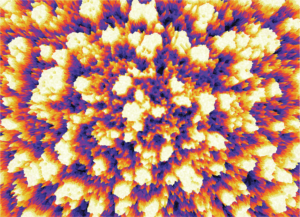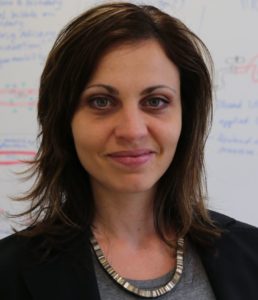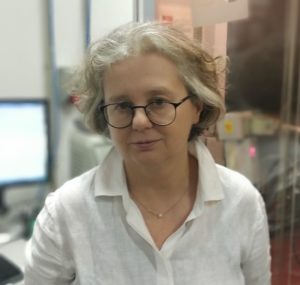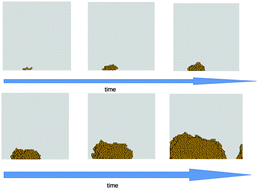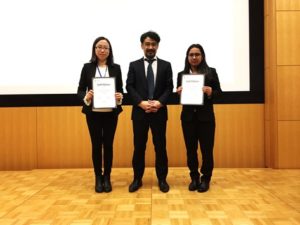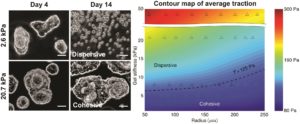Do you know an early-career researcher who deserves recognition for their contribution to the soft matter field?
Now is your chance to put them forward for the accolade they deserve!
Soft Matter is pleased to announce that nominations are now being accepted for the 2020 Soft Matter Lectureship award. This annual award was established in 2009 to honour an early-stage career scientist who has made a significant contribution to the soft matter field.
The recipient of the award will be asked to present a lecture at an international conference in 2020, where they will also be presented with the award. The Soft Matter Editorial Office will provide financial support to the recipient for travel and accommodation costs.
The recipient will also be asked to contribute a lead article to the journal and will have their work showcased free of charge on the front cover of the issue in which their article is published.
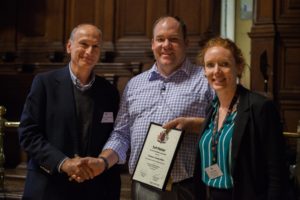
Prof Tim White receiving his Soft Matter Lectureship award from Professor Dimitris Vlassopoulos (left) and Laura Fisher (right)
Previous winners
2019 – Timothy J White, University of Colorado, USA
2018 – Susan Perkin, University of Oxford, UK
2017 – Daeyeon Lee, University of Pennsylvania, USA
2016 – Damien Baigl, Ecole Normale Supérieure, Paris, France
2015 – Lucio Isa, ETH Zürich, Switzerland
2014 – Eric Dufresne, Yale Univeristy, USA
2013 – Eric Furst, University of Delaware, USA
2012 – Patrick Doyle, MIT, USA
2011 – Michael J. Solomon, University of Michigan, USA
2010 – Bartosz Grzybowski, UNIST, Republic of Korea
2009 – Emanuela Zaccarelli, University of Rome, Italy
Eligibility
To be eligible for the lectureship, candidates should meet the following criteria:
- Be an independent researcher, having completed PhD and postdoctoral studies
- Be actively pursuing research within the soft matter field, and have made a significant contribution to the field
- Be at an early stage of their independent career (this should be within 12 years of attaining their doctorate or equivalent degree, but appropriate consideration will be given to those who have taken a career break or followed an alternative study path)
Although the Soft Matter Lectureship doesn’t explicitly reward support of or contributions to the journal, candidates with no history of either publishing in or refereeing for the journal would typically not be considered.
Selection
- Eligible nominated candidates will be notified of their nomination, and will be asked to provide 3 recent articles that they feel represent their current research.
- All eligible nominated candidates will be assessed by a shortlisting panel, made up of members of the Soft Matter Advisory Board and a previous lectureship winner.
- The shortlisting panel will consider the articles provided by the candidates as well as their CVs and letters of nomination.
- Shortlisted candidates will be further assessed by the Soft Matter Editorial Board, and a winner will be selected based on an anonymous poll.
- Selection is not based simply on quantitative measures. Consideration will be given to all information provided in the letter of recommendation and candidate CV, including research achievements and originality, contributions to the soft matter community, innovation, collaborations and teamwork, publication history, and engagement with Soft Matter.
Nominations
- Nominations must be made via email to softmatter-rsc@rsc.org, and should include a short CV (3 page maximum length) and a brief letter of nomination (1 page maximum length)
- Self-nomination is not permitted.
- Nominators do not need to be senior researchers, and we encourage nominations from people at all career levels.
- As part of the Royal Society of Chemistry, we believe we have a responsibility to promote inclusivity and accessibility in order to improve diversity. Where possible, we encourage each nominator to consider nominating candidates of all genders, races, and backgrounds.
- Candidates outside of the stated eligibility criteria may still be considered.
Nominations should be submitted no later than 30th November 2019.
Comments Off on Nominations now open for the 2020 Soft Matter Lectureship
 Amy Shen is a professor in Micro/Bio/Nanofluidics Unit at Okinawa Institute of Science and Technology Graduate University in Japan. Her research is focused on microfluidics, rheology, and self-assembly, with applications in nanotechnology and biotechnology. She received the Ralph E. Powe Junior Faculty Enhancement Award in 2003 and the National Science Foundation’s CAREER Award in 2007. Amy was also a Fulbright Scholar in 2013. More recently, she gave the 2019 Bergveld lecture at the University of Twente, Netherlands. She is an associate editor for Micromachines, Biomedical Microdevices, and belongs to the editorial advisory boards of VIEW and Physics of Fluids. Amy is also a Series Editor for the RSC Soft Matter book series.
Amy Shen is a professor in Micro/Bio/Nanofluidics Unit at Okinawa Institute of Science and Technology Graduate University in Japan. Her research is focused on microfluidics, rheology, and self-assembly, with applications in nanotechnology and biotechnology. She received the Ralph E. Powe Junior Faculty Enhancement Award in 2003 and the National Science Foundation’s CAREER Award in 2007. Amy was also a Fulbright Scholar in 2013. More recently, she gave the 2019 Bergveld lecture at the University of Twente, Netherlands. She is an associate editor for Micromachines, Biomedical Microdevices, and belongs to the editorial advisory boards of VIEW and Physics of Fluids. Amy is also a Series Editor for the RSC Soft Matter book series.










